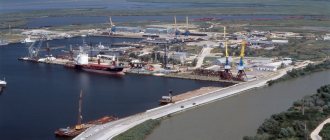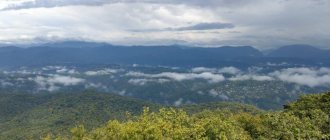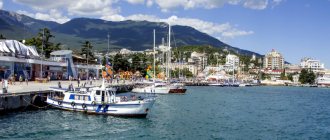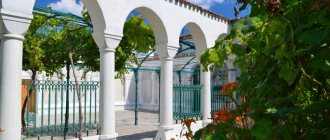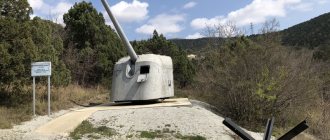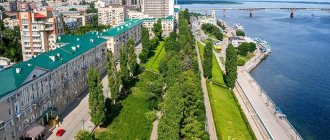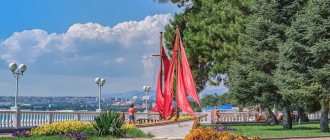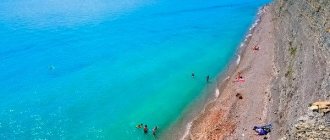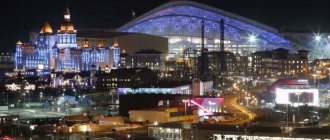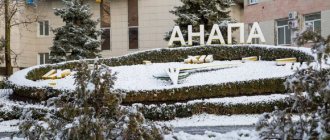The city was founded in 1929. There are two versions of the origin of the name: due to its location, because the Ukhta River flows into Izhma on the left side, “vuk” - left; from the word “uhta”/“vukva”, which translated from the Komi-Zyryan language means “tasteless water”.
There is also a legend about a leader who had been looking for a place for his people for a long time. The man sailed in his boat for several days. And suddenly I saw a wonderful sunset, the reflection of the rays of which, like a path, went into the distance. The leader of the northern people was fascinated by the view and exclaimed “Wow!”, which is how the city got its name.
The first structures appeared thanks to the hard work of prisoners, peasants, exiles and other lower strata of the population. Back in the 15th century, these lands attracted industrialists and miners with their numerous deposits of “black” gold. That is why Ukhta is called the oil capital of Komi. Here, in the 19th century, the development of the oil industry began: expeditions, drilling of wells and transportation of the product to other cities.
At the moment, Ukhta serves as the cultural and industrial center of the Komi Republic. The history of the city is associated with the following names: Kapustin S. A., Derzhavin A. V., Aprelsky S. A., A. A. Chernova, N. V. Oplesnina and others.
More interesting and beautiful places in the Komi Republic near Ukhta and beyond - in this detailed review.
Religious buildings
The city lacks ancient temples and churches with a long history, since during the Soviet era religion was subjected to serious persecution in the country. Only at the end of the last century did the believers of Ukhta get the opportunity to build places of worship and participate in divine services.
Church of the New Martyrs and Confessors of Russia who shone forth in the land of Komi
A huge modern temple was built with funds from local entrepreneurs and ordinary city residents on Ziryunov Street 5A.
The construction of the red brick building took about 8 years and was completed in 2012. Today, regular church services are held here.
Stephen's Church
The Church of St. Stephen of Great Perm is located in a building from the middle of the last century, a former cultural center on Oktyabrskaya Street 8. This rather large basilica extension was given to the church in a state of disrepair. Some of the premises were illuminated already in 1993, after which a major renovation of the building was carried out. At the beginning of this century, a 4-tier iconostasis appeared in the temple.
Senyukova Street
V. M. Senyukov is an outstanding Soviet petroleum geologist. One of the initiators of introducing the deep reference drilling method into oil and gas exploration practice. The first Doctor of Geological and Mineralogical Sciences in the USSR (1938) - without defending a dissertation, for the discovery of oil fields in Eastern Siberia. Vasily Mikhailovich Senyukov greatly contributed to the development of geological exploration in the Komi Autonomous Soviet Socialist Republic and the Timan-Pechora province, took an active part in the development of strategies and tactics for oil and gas exploration in the republic, and led many studies. He was an indispensable participant in almost all geological conferences in the Komi ASSR
His reports and speeches, published in conference proceedings, still attract attention for their originality, severity, and special vision of geological problems. In 1952 he was arrested and placed in Lubyanka
The reason for the arrest could be that the plan he presented for oil exploration in the country required huge funds. Soon released. They say that Stalin’s words applied specifically to Senyukov: “I cannot allow Stalin’s laureate to be shot twice.” The memorial plaque was installed on Senyukova Street, building 3, on August 22, 1981.
Natural attractions
The nature of the river valley, surrounded by high cliffs and stone ridges, is unique in its own way. The most ancient plants have been preserved here, and by studying them you can see what these regions looked like several thousand years ago. Several nature reserves and sanctuaries have been created on the territory.
Lake Bolshoye Paraskino
The unique reservoir of karst origin is the habitat of a representative of the ancient fauna of the Ice Age - the lacustrine gamarus. In addition, rare algae listed in the Red Book grow here.
The lake is very picturesque. Its banks are overgrown with beautiful forests, where locals love to walk and relax in the fresh air.
Chutinsky Nature Reserve
A unique place for preserving and studying the nature of the Syuzyu and Chut rivers, located within the city, covers an area of about 6 thousand square meters. km. Local residents love walking around the reserve. During the summer and autumn seasons, mushrooms, blueberries and cranberries are collected here.
Eshmes Cave
At the end of the last century, a unique pagan sanctuary of ancient people was found. Bronze and silver items, ancient tools, pagan idols and many remains of various animals were discovered in the Eshmes cave. The cave is located 100 km from the city in the Bely Eshmes game reserve.
See also: Canberra is the capital of Australia. Photos, where it is located, attractions, what to see
White Kedva
The largest natural reserve located near Ukhta. Here you can see rare species of flora and fauna listed in the Red Book of the Russian Federation. Most of the reserve is made up of coniferous forests located along the river of the same name.
Nature reserves "Belaya Kedva", "Sedyuksky", "Chutinsky"
A number of nature reserves have been created in the Komi Republic. In the vicinity of the city of Ukhta there are also beautiful protected areas that are local natural attractions. They carefully preserve the beauty of nature in its original form. Of great interest are the rivers and forests, the unique landscape, and rare species of flora and fauna of the local region.
In the Belaya Kedva reserve
Where is
Ukhta, whose attractions date back several decades, was originally named after the village of Chibyu, and the city received its modern name in 1939. The large industrial center is located 320 km northeast of the capital of the republic on the banks of the river of the same name, occupying an area of 13.3 thousand km. More than 120.5 thousand people live here today.
On the edge of the city there is a small airport that accepts direct flights from Moscow and St. Petersburg. The flight takes about 2 hours, the flight from Syktyvkar lasts a little less than 1 hour.
There are also regular flights to major cities in the country:
- Yekaterinburg;
- Krasnoyarsk;
- Tyumen;
- Voronezh;
- Samara;
- Novosibirsk;
- Vorkuta;
- Usinsk.
From the airport in the village of Dalniy to the city center there is bus route No. 12. A taxi ride will take no more than 20 minutes. and will cost from 150 to 200 rubles. You can also get to Ukhta using a well-established railway connection. Travel from Moscow takes not much more than a day, and from the northern capital it lasts about 33 hours.
The railway station is located in the city itself. The following public transport routes No. 2, 3, 7, 9, 12 pass through it, which will conveniently deliver passengers to any part of the city.
In the central part of the city on Oktyabrskaya Street there is a bus station that connects Ukhta with all nearby settlements. The bus covers the distance from Syktyvkar in 4.5-5 hours. Flights depart regularly, several times a day. The cost of a ticket is 500-700 rubles.
Weather, best time to travel
The city is located in the temperate continental climate of the Far North with the predominant influence of Arctic air masses. Winters here are long and cold. The air temperature drops to -20 °C. Thaws and short-term temperature drops to -40 or -50 °C are possible. The ground freezes up to 2 m deep, but there is no permafrost.
Snow usually falls in October and remains until the end of April. The heating season is about 260 days a year. Summer is short and not hot. The air in July warms up from +17 to +21 °C. In summer there is a large amount of precipitation.
Chibyu River and the birth of the city
Speaking about the Ukhta River, one cannot help but talk about one of its tributaries - the Chibyu River. The history of the city began with it, when on August 21, 1929, the Ukhta expedition of the OGPU landed in the place where Chibyu flows into the Ukhta River and the construction of a village began, called Chibyu. Until the 60s of the last century, the river was really fast, high-water and clean; in some places the depth reached three meters. Forests grew on both banks, red and black currants grew in the lowlands, and fish were found. The trees did not allow it to dry out. But the city was being built and advancing on Chibyu. In the first half of the 70s, from the village of Zabolotny, all the way to the Ukhta River, a canal was dug - a new artificial channel of the Chibyu River. The canal was built almost three meters lower than the old riverbed, and the difference in height is visible in the area of the bridge to Shudayag.
The site for construction was, of course, freed up, the groundwater level in a vast area was significantly lowered, but the city lost a beautiful river, beaches and forest. The deadliest blow to Chibyushka came in 1975. Old Ukhta residents, of course, remember that on Zabolotny, where there is now a memorial sign to the victims of political repression, there was a zone. And across the road, on the site of the Lukoilov gas station, there are two large camp pigsties. When the pigsties were demolished, all the manure from the manure storage facility was simply shoveled into the river, killing all the fish. Unfortunately, today Chibyu is more like a large drainage ditch; in some places the river does not freeze in winter, as warm water flows from the sewage outlets. City residents also contribute by littering the banks and riverbed with garbage. I would like to note that Chibyushka was not left to the mercy of fate. Thanks to the efforts of Gazprom Transgaz Ukhta LLC, the river bank in the area of Gazovikov embankment has been remarkably landscaped, and from the city the river received a new bridge in the KiO park and landscaping of the pond.
About the history of Ukhta
During the times of Kievan Rus, these lands were owned by the Novgorod feudal republic. There was practically no population on them: only fur hunters. It was oil, and not oil, that for a long time was the most important strategic commodity of these places. People knew that they were rich in oil since the 15th century, but there was no need for it then. But fur was valued.
At the end of the 15th century, during the era of Ivan the Third, the territories in which present-day Ukhta is located were annexed by the Moscow Principality. In the 20s of the 16th century. The beginning of the Ukhta oil fields was laid. In 1745, with the approval of the Berg College, merchants founded the first “oil refinery” in Russian history in Ukhta.
It worked like this: oil was scooped up from the river surface and from coastal pits. Over the 20 years of the field’s existence, “as much as” 3.5 tons of oil were produced this way. In 1872-1873 The first well was drilled, from which 32 tons of oil were pumped out.
Nowadays, the old town of Ukhta is recognized as an object of historical and cultural heritage
At the beginning of the twentieth century, there were more wells. The Baltic German Alexander Georgievich Gansberg built an oil refinery (kerosene) plant and a power plant here. In 1918, the Soviet government nationalized the Ukhta oil fields.
The city of Ukhta arose on August 21, 1929, as a settlement of forced oil workers founded by the OGPU. There were 125 of them: political prisoners, criminals, dispossessed kulaks, as well as guards assigned to them, plus specialists - geologists and oil workers. At first the village was called Chibyu. New batches of prisoners were periodically sent there, for whom a 12-hour working day was established, without days off.
Oil production on an industrial scale was established in the fall of 1930. After this, roads and railways began to be built to the oil fields. In 1933, in the Ukhtpechlag of the village of Chibyu there were about 5 thousand prisoners and 206 civilian residents. The civilians lived in two-story wooden houses, the prisoners lived in barracks. In 1939, the village was renamed Ukhta.
In 1941, industrial gas production was established in this region for the first time in the history of our country. The leadership of the Komi ASSR planned at that time to move the capital of the republic from Syktyvkar to Ukhta. But with the outbreak of war, this project was postponed. Since 1943, Ukhta received official city status.
After the war, the oil and gas and processing industries, as well as the production of building materials in Ukhta began to develop at a very high pace. Pipelines were built to transport oil and gas.
Eshmes Cave
This cave is a unique historical and archaeological monument. This is an ancient sanctuary of the indigenous peoples of the region, in which pagan rituals were performed.
Eshmes Cave
During the research and excavations, scientists found ancient artifacts in it that tell about the lifestyle, customs and way of life of the local population. Including spear tips, animal bones and teeth. As well as 35 different items made of silver and bronze: pendants and plates, 1 image of the Permian animal style, 2 silver coins - the first Iranian from the mid-10th century, the second from the German early 11th century. The most valuable finds were recognized as two idols, which were deposited in the local history museums of Ukhta and Syktyvkar.
Location: tributary of the river. White Ashmess.
Museum of 20th Century Migrants
A private museum, created by a local collector-enthusiast, head of the research club, Victor Moor. The museum was based on its collection of antiques, things and household items of the first half of the twentieth century.
This extraordinary exhibition is housed in a railway carriage built in 1902. Most of the exhibits presented in the museum came from immigrants to Ukhta from other regions of Russia - hence the name.
Museum of 20th Century Migrants
In addition to the unique feeling of traveling back in time, a visit to the Museum of 20th Century Migrants gives the visitor a deep understanding of how much human life has changed over these decades, how much easier and more comfortable it has become for everyone these days.
Address: st. Bushueva, 5b.
Education
There were positive emotions about our university. The rector thinks highly of him. The university is quite popular in Russia and the largest specialized one in the north-west. To be honest, you won't learn much there. But student life is very exciting
Much attention is paid to students' leisure and sports. There is even a sanatorium where students can relax almost free of charge.
But after graduating from the most prestigious specialty at the university, I was never able to find a job in the city. Therefore, now I am forced to travel to a village 130 km away in order to somehow improve my professional skills. And it's not that I didn't look well. The problem is that all the places are already occupied for 40 years in advance. Already now, every head of a production department knows where his son, grandson, nephew and son-in-law will work. Seriously, you shouldn’t hope to get a job at Transneft, Gazprom or Lukoil in this city without having connections. But most people are attracted to Ukhta by high salaries and living standards.
Parks and monuments of Ukhta
Eternal flame
Address: st. Mira, 13
The Eternal Flame begins its history in May 1980, its flame was lit by Nikolai Zalozhnykh, a participant in the Battle of Stalingrad.
8 granite slabs were erected on the memorial square, the text of which expresses grief and tribute to those who died during the war.
This is where the letter with an appeal to the descendants of 2045 from the front-line soldiers is located.
Monument to the Pioneers of the North
Coordinates: N 63° 33′ 47.2572″ E 53° 42′ 32.688 Address: st. Factory
The memorial is a stele with two oil derricks.
The monument was erected at the landing site of geological expedition No. 1, which gave rise to the birth of the city.
Memorial sign “The First Oil Field in the North”
Address: st. Bushueva, 15
The monument is located at the site of the discovery of the first oil field in the North.
It was discovered in 1930.
Memorial of Remembrance
Address: Victory Square
The memorial is dedicated to the Ukhta residents who died in the Great Patriotic War and consists of the Eternal Flame, 1938 cannons and the Memory Wall.
The monument was created with the help of funds and efforts of local residents.
Monument to A. S. Pushkin
Address: Pushkin Square
The monument to the great poet was opened in 1937. The sculpture was made of brick and concrete and had no frame.
The author of the project is political prisoner N.A. Bruni. Locals say that this creation served as a symbol of protest and hope for the prisoners of the Gulag camp.
In 1997, the monument was dismantled and a copy was installed.
There is a legend in the city that above it you can see a cloud of a bizarre shape, reminiscent of the image of Alexander Sergeevich’s beloved, Natalie.
Monument to A.S. Pushkin
One of the main monuments in Ukhta is the monument to the great poet Alexander Sergeevich Pushkin, erected on Oktyabrskaya Square in 1999, on the eve of the 200th anniversary of the birth of the famous Russian writer.
Interestingly, this monument was a copy of another monument created by prisoners of Ukhtpechlag in 1937 to commemorate the 100th anniversary of Pushkin’s tragic death in a duel. It was made of plaster, cement, brick, and installed on a wooden pedestal. The sculpture did not have a metal frame, and it gradually collapsed over time.
Monument to A.S. Pushkin
The author of the original version, prisoner Nikolai Bruni, received a reward for his work from the camp authorities: several days of an unofficial meeting with his wife who came to see him. Just a few months after this, he was shot, having been convicted of “counter-revolutionary agitation” among prisoners. And the family was only informed many years later that he had died of pneumonia. In 1956, Bruni was posthumously rehabilitated.
The monument he created was very much loved in Ukhta and, despite its fragility, was maintained with repairs until the 1990s. And the bronze Pushkin became his copy.
Address: st. Pushkin.
St. Stephen's Cathedral
The cathedral was built between 1856 and 1896. such a long period of construction is explained by the fact that it was carried out with donations from the population, who were long and reluctant to part with money. The consecration of the cathedral took place on a significant date - the 500th anniversary of the death of Stephen of Perm, whose name the temple bears. Stefan of Perm carried out active missionary work among the Komi-Zyryans, compiled the alphabet of the Zyryan language, and was the first Perm bishop. After his death he was canonized. The cathedral was less fortunate: during the years of struggle against religion in 1929, it was turned into a workers' club with a canteen attached to it, and in 1932 the temple was completely dismantled to the ground.
Orthodox churches in the city of Ukhta
Ukhta is a young city, 100 percent Soviet, so you won’t find any iconic architectural monuments in it. All local churches can be called objects of modern Orthodox culture of the Russian Federation.
In the 1990s, the Central House of Culture for Oil Workers, built under Stalin, was adapted into the first of them, the Temple of Stephen the Great. The first services were held there in 1993.
Temple of Stephen the Great
The second temple - the Church of the Intercession of the Blessed Virgin Mary - was built with the participation of Gazprom LLC in the late 1990s / early 2000s. This church is wooden, built in the style and traditions of ancient architecture of the Russian North.
Church of the New Martyrs and Confessors of Russia, who shone in the land of Komi
The third is the Church of the New Martyrs and Confessors of Russia, who shone in the land of Komi - this is a golden-domed stone temple, built in the 2000s/2010s according to the design of a group of Yekaterinburg architects. It stands on the bank of the river and is beautifully reflected in its waters. The temple accommodates 1,500 parishioners. It was built near the place where the prisoners who died in Ukhtpechlag were buried
Addresses: st. Oktyabrskaya, 8, Zeryunova Ave.
Ukhta Folk Drama Theater
This theater is the oldest in the Komi Republic. It was founded in 1934 on the initiative of prisoners of Ukhtpechlag. Moreover, from the very beginning he was not amateur, but, one might say, professional: there were enough prisoners - artists, musicians and representatives of other creative professions in these places.
The first artistic director and director of the theater was Joseph Girnyak, a political prisoner and theater actor from Ukraine, who was imprisoned in Ukhtpechlag from 1933 to 1937. The repertoire of the “theater behind barbed wire” is impressive: J. Bizet’s opera “Carmen”, performances by M. Gorky “At the Lower Depths”, A. Ostrovsky’s “Dowry”, etc.
Ukhta Folk Drama Theater
A new creative stage of the theater began in the 50s, when an excellent Central House of Culture was built in Ukhta.
All the best in the history of this theater is associated with Vera Mikhailovna Goi, who has been its permanent director since 1974. Therefore, it is often called the “Theater of Vera Goy”. Since 1997, the “Theater for Children” has been operating at the People's Drama Theater; The traditional festival "Fun" is held.
Address: Lenin Ave., 26 (House of Culture).
Academic Drama Theater named after. V. Savina
- The theater is named after the first playwright from the Komi people, Viktor Savin.
- The interior of the theater is slightly pretentious, but technical changes allow performances to be held in two halls simultaneously, there is a video recording studio
- At night, thanks to colorful lighting, the building serves as a street decoration
The theater building was built in 1978. The simple geometric shapes and focus on practicality characteristic of Soviet architecture are visible in the appearance of the building, although it has been completely rebuilt (in 2007 the old building was demolished, a new one began to be built according to a similar design). The renovated theater opened in 2009.
Corruption and wage levels
I'll start with the kindergartens in order. There seems to be room in them. But there are at most 5-7 normal kindergartens where you can safely leave your “children” and be sure that they won’t be poisoned there or some chest of drawers will fall on their heads. One friend recently managed to place her child in one of these with the help of a couple of bribes totaling 30 thousand rubles. She is terribly happy. Now he can go to work, because he needs to save money for school!
The city is truly corrupt. You can’t get a single piece of paper without finance. Nobody wants to work in a free hospital. Recently, problems arose with the meniscus in the knee joint. It turned out that there is only one orthopedist per 100 thousand residents, and he is on vacation. Waited for him to return. They gave me a ticket for 16:00. Came at 15, went for an appointment at 21. Thank God, the doctor is conscientious - he overworks for a couple of hours every day. By the way, for the simplest operation to remove the ill-fated meniscus, I had to go to Syktyvkar, because in Ukhta with its famous “san town” such things are not done.
The average salary in the city, according to Internet data, is 38 thousand rubles. I don't know where these numbers come from. My mother is a teacher with 30 years of work experience and the maximum rank earns 20 thousand. My sister is a doctor, she studied for 8 years, has been working for four, and earns 18. To be honest, working as a salesperson in a store, you can earn a little more, and if you work two shifts, that's generally good. The actual salary level, not taking into account “bosses,” is 20 thousand rubles.
How to navigate
It is convenient to move around the small city on foot, especially since the historical part of the center is located very compactly. City public transport is represented by numerous bus routes, conveniently connecting all parts of the city with each other and with the center. Buses of varying capacities run along the streets of Ukhta in 14 different directions.
The operating period of public transport lasts from 6 to 21 hours. The traffic interval is from 5-10 minutes. up to half an hour, depending on the time of day. The price of a travel ticket is 20 rubles. It is also convenient to get around the city by taxi. You can call a car very quickly by calling. Taxis operate 24 hours a day. The cost of the trip starts from 100 rubles.
Numerous attractions of the original Ukhta will unexpectedly surprise travelers and tourists, leaving the most favorable impression of visiting the oil center of the Komi Republic with the interesting Stalinist architecture of the Old Town, national flavor and the harsh nature of the Far North.
Church of the Intercession of the Blessed Virgin Mary
Construction of the temple began in the 90s of the last century, and the first stone of the future church was consecrated in 1995. However, after some time, construction stopped due to a change in management. Only in 2000 did construction resume and was sponsored by local entrepreneurs. In 2002, services began to be held in the cathedral.
The church building consists of two floors: on the first floor, built of brick, there is a Sunday school and library, and on the second, wooden floor, there is the church itself. The church is part of the temple complex along with the Cathedral of New Martyrs and Confessors of Russia.
Location: Zeryunova Avenue - 7.
The main museums and exhibitions of Ukhta
Ukhta became a city in 1945. However, the history of the development of these territories goes much deeper into history; since the times of ancient Rus', these lands were part of the Novgorod principality; the first mention of the presence of oil here dates back to the 15th century. In this regard, there are many interesting museums here.
Museum "Geological Collection"
Address: Mira street, 5.
Geology for the city of Ukhta is an important science. A representative of this branch of knowledge, B. Wasserman, in 1971 initiated the creation of a museum that will immerse visitors in prehistoric times and tell about the history of understanding the secrets of geology in this area. The collection includes:
- minerals and minerals,
- jewelry made using local stones,
- photographs and documentary materials about geological expeditions.
Interest in the museum is fueled by a diorama - a large-scale artistic canvas dedicated to the ancient world and referring to the secrets of the distant past of planet Earth.
Museum "Nature of the Earth"
Address: st. Oplesnina, 28.
Among the museum attractions of Ukhta, popular among tourists, is the public museum “Nature of the Earth”. Nowadays it is located in a specially designated three-story building on Oplesnina Street, which was built in 1984.
The exhibition itself began to take shape almost four decades earlier. The history of the museum is connected with the name of cultural worker K.F. Sedykh, he founded it and was the permanent leader here for a long time. The first location of the exhibits was the home of the initiator and creator.
The Museum of Nature tells visitors about natural history, the creation of the world and the development of life on earth from a scientific point of view. In the halls you can learn about the origin and varieties of various living creatures - insects and fish, birds and mammals, etc.
Museum of 20th Century Migrants
Address: st. Bushueva, 5B.
A private museum founded by Victor Moor. This man is known in the city as a researcher of the history of Russian Germans and the head of a research club. The museum is based on its collection of antiques, which consists of a variety of interesting things and household items from the beginning of the last century.
Most of the exhibits presented in the museum for visitors to see were given to Viktor Petrovich by settlers who came to Ukhta and the surrounding area. Hence the name of the attraction. The exhibition is housed in a carriage manufactured in 1902, which in itself is extremely interesting.
Museum of Health History
Address: st. Kosolapkina, 4.
In 1995, on the initiative of a group of medical workers, a museum was organized in the building of clinic No. 1, telling about the development of medical practice in the city of Ukhta. The history of medicine in Ukhta turned out to be inextricably linked with the Gulag department located here. Among the doctors who raised health care in the city were prisoners and “camp doctors” from the NKVD.
In the documents and materials of the museum, much attention is paid to the fate of doctors. The exhibition consists of several thematic blocks
They are dedicated to pioneers of medicine, honored doctors, excellent healthcare workers and doctors who participated in the Great Patriotic War.
Museum of the History of the Vodny Village
Address: st. Lenina, 16, Vodny town.
In the village of Vodny, which is an urban area, there is a museum, now part of the “Museum Association”. It originated in 1971
The village is known for its radium mining, which is given special attention in the museum’s exhibition; the history of the local area is also presented in its halls. The museum is housed in the building of the village cultural center
Interesting places to relax with children
The sights of Ukhta can be explored by the whole family with children. It will be very interesting to visit the Earth Nature Museum on Oplesnina Street 28. Every year the museum receives more than 8 thousand visitors. Here you can see interesting exhibitions with various animals, fish, birds and insects. Opening hours: 8 a.m. to 4:00 p.m. daily, except Mondays.
Both children and adults will enjoy the entertainment of the Gladiator paintball club on Vetlosyanovskaya Street 16. You can visit the establishment on weekends from 10 a.m. to 6 p.m.
On Gazovikov embankment 4/2 there is an quest studio called Prisoner. Interesting entertainment events are held here for visitors of all ages. The establishment is open 24 hours a day, 7 days a week.
The Ukhta Planetarium is located in the children's park on Pushkina Street 25A next to the mini-zoo, which is open daily from 10 a.m. to 6 p.m. You can visit it for a nominal fee of 50 rubles. for a child and 150 rub. for an adult.
The Dragonfly family entertainment center is located in the Yarmarka shopping center on Stroitelnaya Street 2A. Interesting entertainment events, master classes and children's discos are held here. You can play in various labyrinths, inflatable and soft areas, and game rooms. There are many different attractions, a cinema, cafes and animation entertainment.
Churches and temples of Ukhta
Church of the New Martyrs and Confessors of Russia who shone forth in the land of Komi
Included in the complex of the Church of the Intercession of the Blessed Virgin Mary. Local residents say that the church was built on the site of the first burials, which is considered holy.
Inside there is a myrrh-streaming icon of the New Martyrs, created by the best icon painters.
Church of St. Stephen the Great
The church is located in the building of the city's former cultural center. The temple consists of a library, baptism and Sunday school.
Inside are icons painted by a local school teacher.
Church of the Intercession of the Blessed Virgin Mary
The temple was built thanks to the efforts of local residents. It is a two-story building, where the abbot’s office, library and school are located on the first floor, and the prayer house is located on the second floor.
Inside is an iconostasis made by prisoners.
Included in the complex of the Cathedral of New Martyrs and Confessors of Russia.
Cabinet-museum of Andrei Yakovlevich Krems
An ordinary courtyard in the center of Ukhta.
Here, in one of the standard apartments, there is the office-museum of Andrei Yakovlevich Krems.
He himself lived in a neighboring apartment, and came here to work. Since 1982, the office-museum has been considered a monument of republican significance. Personally, I found it interesting because the spirit of that era was very well preserved here.
The library of Andrei Yakovlevich Krems was considered almost the largest in Ukhta; in total, the office contained almost eight thousand printed publications: over two thousand books and a little less than six thousand newspapers and magazines. All of them are still in place.
Church of St. Stephen the Great
The idea of creating an Orthodox church in the city arose back in the 60s of the last century. For this purpose, the city population bought a house on Sevastopolskaya Street, as well as a house for the priest. The icons for the prayer house were drawn by an art teacher at one of the local schools. Later, Father Sergius arrived at this house.
The church attracted a large number of people, however, the authorities did not like it. And, citing the high costs of maintaining the church, Father Sergius was removed from service. In the 80s, the population again raised money and purchased an old house for a church. However, in the spring of 1992, the temple was flooded and could no longer be used. After this, the church was located in the building of the central palace of culture, and in 1993 the church was consecrated for worship.
Location: Oktyabrskaya street - 8.
Church of Christ the Savior
- The building is interesting in architecture, several styles are mixed in it, associations arise with both the church and the Orthodox Church
- The temple belongs to the local community of Evangelical Christian Baptists
- At the Divine Liturgy in the church
In 1995, construction of a house of worship began by a community of Evangelical Christian Baptists. The atypical height of the church - three floors - also arouses interest. The decoration of the temple is ascetic; there are no icons or frescoes. But this does not prevent it from being a center of spiritual culture: there is a Sunday school at the temple, there is a teenagers club, and services are held with the accompaniment of a choir.
Modern objects interesting to visit
The modern shopping and entertainment center Fair on Stroitelnaya Street 2A is very popular among the city’s youth. Here you can visit modern cinema halls, play bowling, take part in various laser tag and airsoft scenarios, have fun in the rope park, trampoline arena or climbing wall. The complex is open daily from 10 a.m. to 9 p.m.
In the summer you can take part in kayaking or catamaran rafting along the picturesque northern rivers, take part in fishing, and quad biking.
In winter, entertainment at ski resorts is of particular interest, where you can go skiing, tubing or snowmobiling. The city also has skating rinks for public skating. Equipment rental costs from 150-200 rubles. at one o'clock.
You can have fun and dance at the Harat's pub nightclub on Stroitelnaya Street 2. The establishment is famous for its good cuisine, modern music, and interesting entertainment.
Mount Vetlosyan with a huge profile of Lenin at the top
A significant landmark of Ukhta is the Vetlosyan Hill, which offers a wonderful view of the entire city. The name comes from the language of the Komi people: “Vetlosyan tui” means “hunting path”. During the GULAG, there was the village of Vetlosyan, next to a woodworking plant, and there was also a first-aid post, which was initially housed simply in army-style tents.
In 1970, on the occasion of the 100th anniversary of Lenin’s birth, an original art object was placed on Mount Vetlosyan, just opposite the railway station, which became one of the main symbols of the city of Ukhta. This is a giant profile of Lenin's head 33 meters high.
Initially, the profile was illuminated at night with 120 lamps, but in the 1990s this lighting disappeared, the metal structures rusted, and the memorial sign was in danger. Only in the 2010s was it restored and the lighting was returned to it.
Mount Vetlosyan with a huge profile of Lenin at the top
It is interesting that this profile, welded from metal pipes, was an “amateur activity” of local authorities - more precisely, the first secretary of the CPSU city committee of Ukhta in 1967 -1974. Nikolai Kochurin. On a trip to the sea, he saw such an object in Batumi, on a mountain, glowing. At home, for the 100th anniversary of the leader, I decided to install the same one, but significantly larger than the Georgian one in size. Realizing that approvals were fraught with long bureaucratic red tape, he organized the installation of a memorial sign without notifying senior management.
Using metal balconies and stairs you can climb to the height of the tenth floor and explore Ukhta not just from the mountain, but also from a bird's eye view.
How long does it take to look around the city?
You can explore the interesting places of the Komi capital in 1–2 days (more time will be required in the cold season). If you travel to out-of-town attractions, additional time may be required. If you didn't finish it in 1 day, you will need a place to stay for the night. There are many hotels of different star levels in Syktyvkar. Here are some options:
- hotel "Builder";
- three-star hotel "Avalon";
- three-star hotel "Kutuzov";
- mini-hotel "StandArt";
- Pullman Hostel.
What else to see
If you have time, visit a few more interesting places - unusual objects loved by tourists and locals.
Monument to the Russian ruble
The monument to the Russian ruble was opened in 2015. The initiative to create an unusual monument belonged to the National Bank of the Republic. The sculpture was created to attract attention to the national currency.
Information for tourists:
- address: Lenin Street (next to the National Bank building);
- exact coordinates: 61°40'10″N 50°50'10″E;
- You can explore the attraction at any time.
Sometimes you can see flowers near the monument, which indicates the attitude of the locals towards this monument
Art object "Metro"
The “Metro” art object is a sound installation in the arch of an ordinary residential building. “Metro” was installed in 2013, disguising several speakers in the walls of the arch. Every 15 minutes, the sounds of the subway are broadcast: passing cars, the voice of the dispatcher, the clicking of heels, the voice of a beggar and music. The creators of the art object are the creative team “Akt”. Representatives of the creative team call their creation the future tourist spot of the city, where anyone can merge with underground life. However, some local residents consider the updated arch a sad symbol of the fact that there will most likely never be a metro in Syktyvkar.
Information for tourists:
- address: Lenin street, 89;
- exact coordinates: N61.66487 E50.84261;
- installation opening hours: from 9:00 to 19:00;
- You can come to Metro at any time.
Finding yourself in an arch with an art object, you can seriously think that you are in the subway, this previously unremarkable place has become so atmospheric
“The sign that everyone takes pictures next to”
The art object “Sign in Syktyvkar, next to which everyone takes pictures” was installed in 2012. In the city center, at the intersection of International and Kommunisticheskaya streets, it attracts not only tourists, but also local residents. Externally, this object resembles an ordinary road sign; it hangs at a height of 2 meters. The sign was made in the creative workshop of A. Lebedev and installed by P. Safronov.
A journalist and photographer I know, Oleg, told me that in 2012, the installation of such signs was an all-Russian action. The flash mob was actively supported by journalists from different regions. Thus, a symbolic object appeared in Volgograd, Khabarovsk, Moscow, Perm, Tyumen and other cities. He also said that parts of some signs were manufactured abroad and installed locally.
True, some signs had to be removed after a couple of years, since increased attention to metal art objects led to its unusability
The art object fulfills its function 100%: not only city guests, but also local residents willingly take pictures with it
Hotels
The city has many opportunities to choose a place for a comfortable stay in various price categories:
- Hotel Serdolik located on the banks of a small river, on Timanskaya Street 11, it offers spacious rooms with a magnificent view at prices starting from 2.7 thousand rubles. per day. The hotel has a common lounge area, barbecue area and facilities. A small kitchen with all necessary equipment, a dishwasher and a coffee maker is available to residents. There is a restaurant at the hotel. Guests can enjoy a hearty continental breakfast each morning and very good coffee.
- The Ukhta Inn mini-hotel is located on Kuratova Street 7. The hotel has its own guarded parking, a sauna, and a restaurant with excellent cuisine, where they prepare a variety of dishes on the menu and serve a delicious breakfast in the morning. All rooms are equipped with a private bathroom, TV with many satellite channels, and an electric kettle. The cost of accommodation in a double room can be selected from 3.3 thousand rubles.
- The European Hotel on Timanskaya Street 10 offers guests comfortable accommodation at prices starting from 4.5 thousand rubles. Spacious rooms with all amenities and free toiletries, a private balcony with magnificent views, air conditioning, modern TV, personal safe and refrigerator. Hotel guests can stroll in the garden, play billiards, and use laundry and drying services. The hotel has a restaurant where they prepare very tasty and satisfying breakfasts.
- The Chibu Hotel on Lenina Avenue 38 has its own bar, shared lounge, and restaurant. A continental breakfast is served every morning. There is a paid guarded parking lot and an ATM. All rooms are equipped with a private bathroom, modern cable TV, desk and electric kettle or coffee maker. The cost of placement can be selected from 2.5 thousand rubles.
- Hotel DragonFlay on Pervomaiskaya Street 24D offers guests cozy modern rooms at prices starting from 3.8 thousand rubles. All rooms have a private bathroom with free toiletries, hairdryer, slippers and bathrobe. The rooms have air conditioning, a modern TV, a refrigerator, a coffee maker or electric kettle, and a small dining area. The hotel has secure parking, a sauna, laundry and ironing, a hairdresser and a beauty salon. The hotel restaurant serves delicious coffee and a hearty breakfast.
- Timan Hotel on Lenina Avenue 4 offers luggage storage, laundry and shoe shine services. The hotel has a coffee shop and restaurant where delicious breakfasts are served in the morning. The rooms are equipped with all amenities and include a refrigerator, TV, small dining area or living room. There are rooms of different price categories, you can choose an option from 1.5 thousand rubles.
See also: Keszthely, Hungary. Sights, baths, photos with descriptions of what to see in one day
